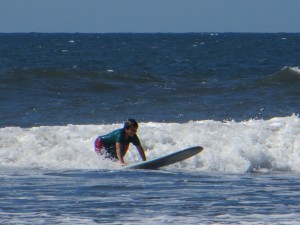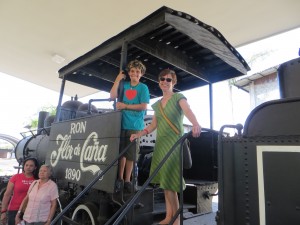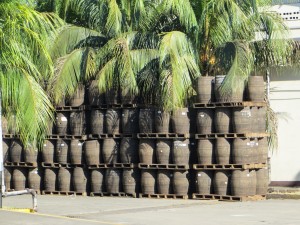Once out of the burning building… no, wait, wrong serial. Oh yeah, when we last left our intrepid heroes, they were about to leave the sunny beaches of El Salvador for the even sunnier towns and cities of Nicaragua.
Editor’s note: it’s over, we’re back in the US&A, and have been so since the end of February. But as soon as we’d made our plans to return, Joe made us promise to keep it a secret, so he could surprise his friends. We kept our promise so well that we haven’t posted to the blog since then. But there’s still plenty to talk about, even in the cold grey “Spring”, so here we are…
We spent longer than we had planned at the Azul Surf Club, at least partially because I experienced the only case of food poisoning on the entire trip. We’d had lunch at the hotel/restaurant down the road (not the Azul Surf Club!), and I’d had the fish soup. It was delicious. I loved it. But at three o’clock the next morning, I had to give it all back, along with the dinner we’d eaten in the mean time. As it was explained to us later, in making fish soup, many restaurants start with a base of seafood and vegetables, and boil it, killing any disagreeable bacteria. But then they add the fish, and often don’t bring it to another boil. Then it boils over on its own, several hours later. Be ye forewarned.
Recovering from my lost lunch, I did little more than hang out at the hotel, which was very comfortable, and friendly, and right on the Pacific. I also slept. And read. Joe and Elizabeth, however, were able to take advantage of this down time, and attend some surfing lessons, given right at the hotel. They loved it, and I had a good time watching. Looked fun. Next time for sure.
Also, while I recuperated, one of the hotel staff was very helpful, and took our most recent flat tire into town to be repaired. The next morning, they let us use their jack—much better than Rocinante’s—and I was able to put the repaired tire and wheel back on the van. Then off we drove, continuing south and east toward Nicaragua.
To get there, we had to pass back through Honduras. No problem, we liked Honduras. But this part of the country, the south-eastern tip right on the Pacific was very different from what we had seen in the northern, Caribbean section. There it was lush, jungle-y and mountainous, here the mountains are much farther apart, and between them is desert-y, flat and hot. We crossed the border, did the dance with Immigration and with Customs, and made our way into Choluteca for the night.
The next morning, at the crack of nine or so, we were back on the road, headed for the next border. The little bit of Honduras separating El Salvador and Nicaragua is only about 130 kilometers wide along the roads we were taking, and Choluteca is already halfway there, so we had not far to go. Of course, border crossings are always the wild card, so we were prepared to spend the night in Chinandega, only 75 kilometers from the border. As it happened, the border presented no outrageous delays, and we made it into Chinandega at lunch time. We found our way to Rostipollo, where the food is quite good, the service excellent and our waiter thoroughly charming. While we ate, we made plans to visit the Flor de Caña distillery.
A word first on rum in general. I’ve never cared for it. It always tasted vaguely medicinal to me. I think Elizabeth was more receptive to it, but wasn’t particularly crazy about it, either. Then, early on in this trip, in Belize City, at the gift shop of the city-prison-turned-museum, I saw some bottles of local rum. It was a brand I’d never heard of, and can’t recall now. But it was cheap enough to try, so I bought a bottle. And that evening decided I’d never had rum before. Positively delicious. We both loved it.
We didn’t stay long in Belize, and were long gone by the time the bottle was empty. So we had to try other brands. In Guatemala, we enjoyed Botran, both the 8- and 12-year varieties. We tried other marks in other countries, but Flor de Caña, the Nicaraguan flagship rum, was the best bet everywhere.
And we learned a lot on the tour. First of all, Flor de Caña is huge. The land they own around Chinandega is much larger than the town itself. The great majority of it is devoted to growing sugar cane (caña). And they have another, similarly-sized chunk of property in another part of the country. Lots of cane. The company is energy-neutral: using solar power and bio-mass from the leftovers of the cane-to-rum process, they generate as much energy as they need. They’re serious about recycling, and are socially conscious as well. All in all, it seems like a pretty good company. And their rum is wonderfully good. We brought home three liters of it, for our own consumption. All gone now. It’s available in the states, but much more expensive.
The tour ended around four in the afternoon. Since we’d parked in the shade, and our destination for the evening was not at all far, Rocinante had little trouble getting us to León by sundown.




